
|
|
|
September 6, 1998, Updated Feb 24, 1999
The weather was perfect as the world's oldest preserved rapid transit car,
Manhattan Railway money collection car "G", took its last run
down the line of the Shore Line Trolley Museum prior to its scheduled
five-year loan to the New York City Transit Museum.
Car G was originally constructed by Gilbert and Bush Co. in 1878 as
car #41. It was a coach
hauled by steam engine along the Third Avenue Elevated line in New
York City. The car was part of an order of 80 cars placed by the
New York Elevated Railroad Company to outfit the newly-constructed
Third Avenue line.
The N.Y.E.R.R. was already operating the Ninth Avenue elevated line.
Competitor Metropolitan Elevated Railway Co. operated the Sixth
Avenue line and started construction of the Second Avenue line in 1878
to compete with the Third Avenue. By 1879, the two companies had been
merged into the Manhattan Railway Co.
In 1893, Manhattan Ry. converted car 41 into money collection car "G".
A sliding center door was added to the car carefully matching the
original window design. As the collection car, "G" ran on all of the
Manhattan Ry. elevated lines.
|
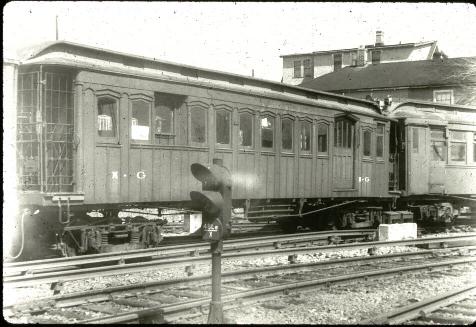 |
| Money car G in service with an MUDC behind it,date and location unknown,courtesy D. Pirmann |
In 1902, the Manhattan els, at this point under the control of the
Interborough Rapid Transit Company (IRT), converted from steam to electric
M-U operation. G was outfitted with a cab, "Hi-V" master
controller and
brake valve on one end of the car, compatible with the new electric
elevated cars being ordered or converted at the time.
G therefore
became a "control trailer", capable of being placed at the front
of a train and controlling its operation, but lacking motors of its own.
Car G saw the beginning of the Third Avenue el, and it also witnessed
the end of the Third Avenue and indeed all Manhattan els in 1955.
It has been preserved and restored at the Shore Line Trolley Museum.
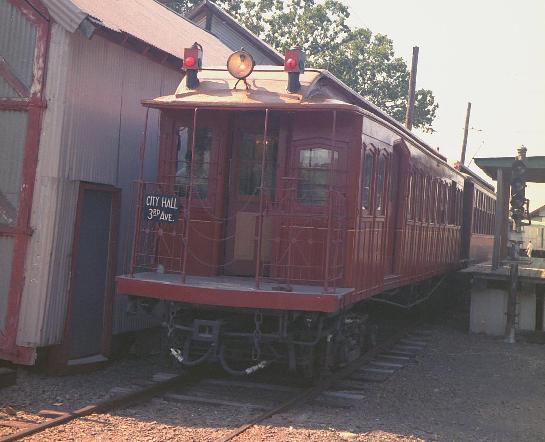 |
| Car G at the head of the train, waiting to depart the el station at the museum, 06-Sep-1998 |
Car G is now on loan to the New York City Transit Museum
located in Brooklyn, NY for a period of five years. Special invitations
were sent out to members of both museums to attend the ceremonial last
day of operation. Turn-out was excellent, and an extra trip had to
be made to accommodate the large number of visitors.
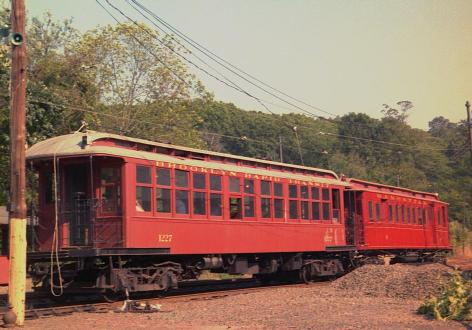 |
| Manhattan el car G and Brooklyn el car 1227 at the museum,06-Sep-1998 |
As car G is a trailer, it requires a motor car to propel it. Selected
for the task this day was Brooklyn Rapid Transit el car #1227, built in
1903 by Osgood-Bradley. Trainline air hoses were temporarily changed on
car G to the BRT style and the 100% manual coupling was made between the
two Van-Dorn bearing cars. Although the electrical systems of the two cars
were not originally compatible, a minor modification by Shore Line master
mechanic Ted E. had been made several years ago to allow the two cars to M-U.
A minor electrical glitch on this day interfered with these plans,
so the train was run other-than-head-car. Equipped with two enormous
150hp motors, 1227 had no difficulty bringing the train up to speed.
Those who attended experienced a rare treat. As the day drew to a close,
the train was parted and the individual cars returned to their sheds.
Now, the process of making G ready for the trip to New York began.
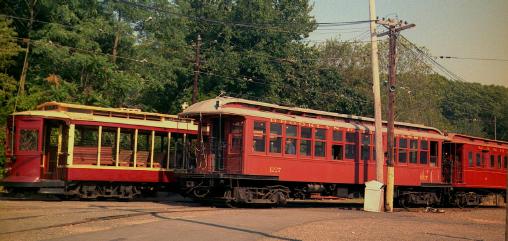 |
| BRT Trolley #4573 meets the el train 1227-G at Farm River Road,06-Sep-1998 |
Car G had been absent from the New York City Transit System's railhead for
over 40 years. In preparation for its return, the point of delivery and
route from there to the NYC Transit Museum's underground location in the
Court Street subway station were carefully planned. As an elevated car,
it was not designed for use in the subway. Clearances were checked and
checked again. Thankfully, the "B" division of the NYC Transit System
provided ample clearances to accept the car, as long as the high marker
lights over the end of the car were removed.
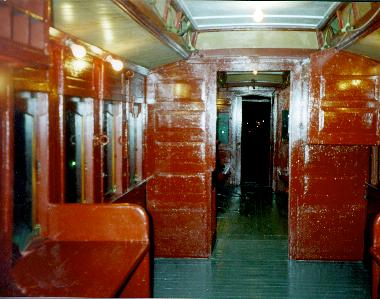 |
| Interior of Car G, N. Gerstein photog. |
Believe it or not, the braking system used on today's diesel locomotives
is compatible with the nearly 100 year old brakes under car G. The only
hitch was a minor difference in the hardware used at the ends of the
hoses that connect the two cars. Car G's original hoses were removed
and stored and brand-new diesel-compatible hoses were installed.
Since a portion of the trip through the subway was to be made with car G
leading, a new automatic stop trip valve was installed on the left side
of the car, in accordance with "B" division standards. Finally, the
car's interior and exterior were prepared for display.
Delivery of Car G was performed on Tuesday, November 17, 1998.
New Orleans trolley car 850 was used as the tow motor, bringing G
up to the end of rail at Sprague Station, East Haven. In a matter of
minutes, the special low-floor trailer truck winched the car onboard
and it was off to New York City via the asphalt.
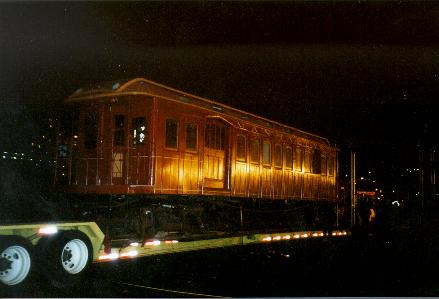 |
| Car G arrives at 207 St. yard,17-Nov-1998,N. Gerstein photog. |
Car G arrived at the sprawling 207 St. maintenance facility at the northern
tip of Manhattan in the early evening. The car was unloaded onto the
car delivery track and diesel locomotive N-2 was brought up behind it.
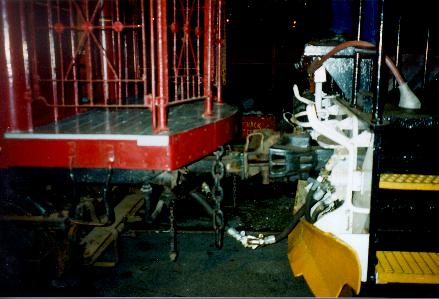 |
| Car G coupled to locomotive N-2,showing Van Dorn to MCB coupler adapter and air hoses,17-Nov-1998,N. Gerstein photog. |
Using a heavy piece of iron known as a "Van Dorn to MCB coupler adapter",
supplied by the Shore Line Trolley Museum, the mechanical connection was
made between the diesel and the 120 year old car. Air hoses were connected,
angle valves were opened and the brake system was charged up and inspected.
Once the evening rush hour had subsided, the odd train made its way south
along the "A" line. A police investigation at 96 St. delayed all southbound
service, including car G, for several minutes. Paused at 145 St., curious
passengers looked inside car G. Several asked "is this the A train? Will
this take me to 42 St.?"
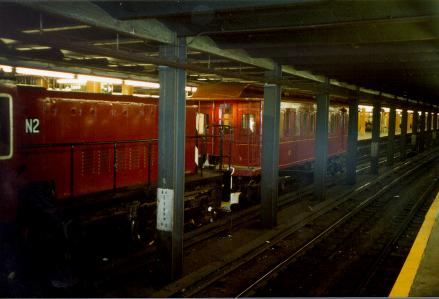 |
| Car G pauses at 145 St. station as curious passengers look on,17-Nov-1998,N. Gerstein photog. |
Soon the train was again underway, operating to 59 St. Columbus Circle, then
via the 6th Avenue line to Jay St., then back to the "A" tracks beyond
Hoyt-Schermerhorn. At this point, the train reversed direction, with car
G being pushed back railroad northward, crossing over and entering
Hoyt-Schermerhorn again, this time against the wall, where it paused
briefly. Then the final leg of the journey brought it west of the Hoyt
station, entering the portal of the stub-end Court Street station,
home of the New York City Transit Museum.
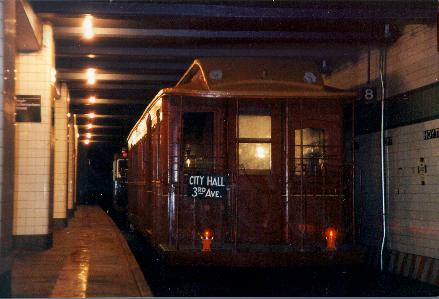 |
| Car G at Hoyt-Schermerhorn,17-Nov-1998, N. Gerstein photog. |
Once there, the diesel was uncoupled. Marker lights, removed for the trip,
were re-installed for display. A jumper was connected to the third rail
to power the car's lights.
On Thursday, November 19, the Transit Museum hosted a special reception
for the car. Invitations were sent to members of both museums and the
platform at Court Street was jammed with guests. Car G is a highlight
of the Transit Museum's ongoing exhibition on the Age of the Els, and
is scheduled to remain on display at Court Street through 2003.









